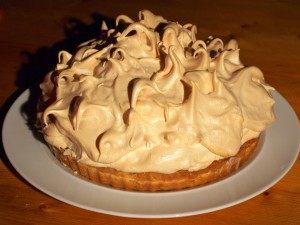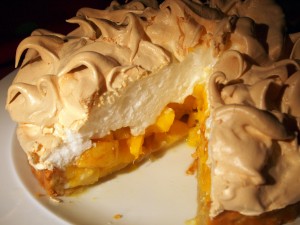
This one’s for my friend Michael and his daughter, who are going in for a pie competition this weekend. I’m very pleased with the way it turned out – it really does taste as good as it looks. This pie is made with an all-butter pastry (none of your revolting shortening here, Californians) which is flavoured with lemon zest, and has a juicy filling that’s very easy to put together. I have been obsessing a bit about meringue recently, and the lovely puffy cloud that makes the lid of this pie is a beautiful and really delicious way to top things off.
Michael and Yael are cooking in the US, where weighing scales are not the norm – unfortunately, cup measures aren’t the norm here in the UK, and I have real trouble using them when I’m baking. As a result, I’ve measured by weight, not volume, below. For those who don’t have a set of scales at home, there is a decent conversion tool here.
You’ll need an 11 inch (28 cm) flan case with fluted edges and a loose base that you can push out, and some baking beans (some use ceramic beans – I just used half a pack of dried butter beans from the cupboard). If you plan on transporting your pie, you may prefer to use a foil dish.
To make one totally fabulous pie, you’ll need:
Pastry
225g plain flour
25g icing (confectioners) sugar
100g salted butter
Zest of 1 lemon
1 egg yolk
3 tablespoons water (approx – see below)
Filling
4 large, ripe peaches (I used white peaches – choose the most fragrant fruit you can find)
3 ripe mangoes (I used Alphonse mangoes, which are my favourite)
2 tablespoons caster sugar
3 level tablespoons semolina (cornmeal for Americans)
Meringue
6 egg whites
225g caster sugar
1 tablespoon white vinegar
 Start by making the pastry. Sift the flour and sugar into a large bowl, and rub in the butter with your fingertips until you have a mixture resembling breadcrumbs. Try to keep things as cool as possible as you work; your pastry will be crisper and shorter if it stays cold. (My grandmother used to make pastry in a large bowl placed in the kitchen sink while she ran cold water around it – perhaps there’s a degree of overkill in this, but it does work well to help your pastry along in hot weather.)
Start by making the pastry. Sift the flour and sugar into a large bowl, and rub in the butter with your fingertips until you have a mixture resembling breadcrumbs. Try to keep things as cool as possible as you work; your pastry will be crisper and shorter if it stays cold. (My grandmother used to make pastry in a large bowl placed in the kitchen sink while she ran cold water around it – perhaps there’s a degree of overkill in this, but it does work well to help your pastry along in hot weather.)
Use a butter knife to stir the lemon zest, yolk and water into the mixture until you have a stiff pastry. You may need a little more water according to the weather; the behaviour of pastry varies horribly according to how much moisture there is in the air on any given day. Wrap the pastry in cling film (saran wrap for Michael and Yael) and put it in the fridge for 30 minutes to rest.
While the pastry is resting, turn the oven to 200ºC (400ºF) and prepare the fruit. Quarter and peel the peaches, then cut each piece into three. Dice the mango in pieces the same size as the peach bits (I’m sure you all know the mango trick, but here’s a YouTube video of someone preparing a mango just in case you’ve not done it before). You can keep the fruit around the stone section to nibble off as a chef’s treat. Cover and set aside.
Roll the pastry out on a cool, lightly floured surface to fit your flan dish. (I have a marble slab for pastry that my Mum bought for me at a gravestone shop. Again, this is probably overkill. It’s also a bit sinister, now I think about it.) Line the dish with the pastry, use a fork to prick the base of the pie case all over, and cut a circle of parchment paper to fit in the bottom. Slip the parchment inside the pie and cover it with baking beans. Bake blind – that is to say, without any filling – for 20 minutes until the pastry is golden. Remove the beans and parchment and cook for another 5-10 minutes or until the base is dry and golden too. Turn the oven down to 150ºC (300ºF).
Prepare the meringue by whisking the eggs and vinegar for about five minutes until you have stiff peaks (the vinegar will not add a detectable flavour to your pie, but it will make the peaks of the meringue simultaneously crisp and chewy, like a baked marshmallow), adding the sugar a tablespoon at a time as you go. You should end up with a very stiff, glossy mixture.
Sprinkle the semolina into the base of the pie dish – this will soak up excess juices from the fruit. Fill the dish with the fruit mixture (depending on the size of your peaches and mangoes, you may find you have some left over to make a fruit salad with) and sprinkle over the sugar.
Spoon the meringue carefully all over the top of the pie in a dome, making sure there are no gaps, and use a spoon to tease it into lots of peaks on top. Put the pie in the oven at the cooler temperature (don’t worry if the temperature hasn’t quite settled down yet – a little bit of extra heat at the start of cooking won’t hurt it) and bake for 1 hour – 1 hour 10 minutes until the pie is an even gold colour all over and marshmallowy inside. Serve warm or cold, but do make it as close as possible to serving as you can manage to keep the meringue nice and high and puffy.
